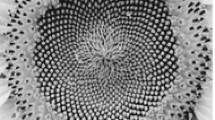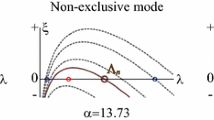Abstract
We study two chemical models for pattern formation in growing plant tips. For hemisphere radius and parameter values together optimal for spherical surface harmonic patterns of index l = 3, the Brusselator model gives an 84% probability of dichotomous branching pattern and 16% of annular pattern, while the hyperchirality model gives 88% probability of dichotomous branching and 12% of annular pattern. The models are two-morphogen reaction-diffusion systems on the surface of a hemispherical shell, with Dirichlet boundary conditions. Bifurcation analysis shows that both models give possible mechanisms for dichotomous branching of the growing tips. Symmetries of the models are used in the analysis.
Similar content being viewed by others
References
Carr, J. (1981). Applications of Centre Manifold Theory, New York: Springer.
Chossat, P., R. Lauterbach and I. Melbourne (1990). Steady-state bifurcation with O(3)-symmetry. Arch. Ration. Mech. Anal. 113, 313–376.
Dewel, G., P. Borckmans, A. de Wit, B. Rudowics, J.-J. Perraud, E. Dulos, J. Boissonade and P. De Kepper (1995). Pattern selection and localized structures in reaction-diffusion systems. Physica A 213, 181–198.
Dumais, J. and L. G. Harrison (2000). Whorl morphogenesis in the dasycladalean algae: the pattern formation viewpoint. Phil. Trans. R. Soc. Lond. B 355, 281–305.
Field, M., M. Golubitsky and I. Stewart (1991). Bifurcations on hemispheres. J. Nonlinear Sci. 1, 201–223.
Golubitsky, M. and D. G. Schaeffer (1985). Singularities and Groups in Bifurcation Theory, Vol. I, New York: Springer.
Golubitsky, M., I. Stewart and D. G. Schaeffer (1988). Singularities and Groups in Bifurcation Theory, Vol. II, New York: Springer.
Goodwin, B. C. and L. E. H. Trainor (1985). Tip and whorl morphogenesis in Acetabularia by calcium-regulated strain fields. J. Theor. Biol. 117, 79–106.
Green, P. B., C. S. Steele and S. C. Rennich (1996). Phyllotactic patterns: a biophysical mechanism for their origin. Ann. Botany 77, 515–527.
Harrison, L. G. (1993). Kinetic Theory of Living Pattern, Cambridge: Cambridge University Press.
Harrison, L. G. and M. Kolár (1988). Coupling between reaction-diffusion prepattern and expressed morphogenesis, applied to desmids and dasyclads. J. Theor. Biol. 130, 493–515.
Harrison, L. G. and T. C. Lacalli (1978). Hyperchirality: a mathematically convenient and biochemically possible model for the kinetics of morphogenesis. Proc. R. Soc. Lond. B 202, 361–397.
Harrison, L. G., S. Wehner and D. M. Holloway (2001). Complex morphogenesis of surfaces: theory and experiment on coupling of reaction-diffusion patterning to growth, in Nonlinear Chemical Kinetics: Complex Dynamics and Spatiotemporal Patterns, Faraday Discuss 120, Royal Society of Chemistry, pp. 277–294.
Holloway, D. M. and L. G. Harrison (1995). Order and localization in reaction-diffusion pattern. Physica A 222, 210–233.
Holloway, D. M. and L. G. Harrison (1999). Algal morphogenisis: modelling interspecific variation in Micrasterias with reaction-diffusion patterned catalysis of cell surface growth. Phil. Trans. R. Soc. Lond. B 354, 417–433.
Hunding, A. and G. D. Billing (1981). Spontaneous pattern formation in spherical nonlinear reaction-diffusion systems: selection rules favor the bipolar ‘mitosis’ pattern. J. Chem. Phys. 75, 486–488.
Hunding, A. and M. Brøns (1990). Bifurcation in a spherical reaction-diffusion system with imposed gradient. Physica D 44, 285–302.
Lacalli, T. C. (1981). Dissipative structures and morphogenetic pattern in unicellular algae. Phil. Trans. R. Soc. Lond. B 294, 347–388.
Lacalli, T. C. (1990). Modelling the Drosophila pair-rule pattern by reaction-diffusion gap input and pattern control in a 4-morphogen system. J. Theor. Biol. 144, 171–194.
Lyons, M. J. and L. G. Harrison (1991). A class of reaction-diffusion mechanisms which preferentially select striped patterns. Chem. Phys. Lett. 183, 158–164.
Meinhardt, G. (1982). Models of Biological Pattern Formation, London: Academic Press.
Meinhardt, G. (1995). The Algorithmic Beauty of Sea Shells, New York: Springer.
Nicolis, G. and I. Prigogine (1977). Self-organization in Non-equilibrium Systems, New York: Wiley.
Prigogine, I. and R. Lefever (1968). Symmetry-breaking instabilities in dissipative systems. II. J. Chem. Phys. 48, 1695–1700.
Ruelle, D. (1973). Bifurcations in the presence of a symmetry group. Arch. Ration. Mech. Anal. 51, 136–152.
Turing, A. M. (1952). The chemical basis of morphogenesis. Phil. Trans. R. Soc. Lond. B 237, 37–72.
Verdasca, J., A. de Wit, G. Dewel and P. Borckmans (1992). Reentrant hexagonal Turing structures. Phys. Lett. A 168, 194–198.
von Aderkas, P., (2000). The influence of exogenously applied cytokinin and abscisic acid on cotyledon number of somatic embryos of hybrid larch (Pinaceae), submitted.
Zimmermann, W. (1952). Main results of the telome theory. Palaeobotanist 1, 456–470.
Author information
Authors and Affiliations
Corresponding author
Rights and permissions
About this article
Cite this article
Nagata, W., Harrison, L.G. & Wehner, S. Reaction-diffusion models of growing plant tips: Bifurcations on hemispheres. Bull. Math. Biol. 65, 571–607 (2003). https://doi.org/10.1016/S0092-8240(03)00025-9
Received:
Accepted:
Issue Date:
DOI: https://doi.org/10.1016/S0092-8240(03)00025-9




